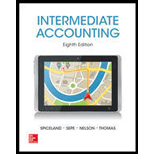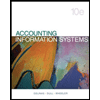
INTERMEDIATE ACCOUNTING
8th Edition
ISBN: 9780078025839
Author: J. David Spiceland
Publisher: McGraw-Hill Education
expand_more
expand_more
format_list_bulleted
Concept explainers
Question
Chapter 13, Problem 13.13BE
To determine
Contingent liability is one form of liability that arises based on a particular outcome of a specific event. They are possible obligation that might arise or might not arise based on the future events. It is otherwise called as probable liability or eventual liability. Following are examples of contingencies:
- Income tax disputes
- Discounted notes receivable
- Lawsuits
- Debt guarantees
- Failure to follow government regulations
To report: Contingent loss (liability)
Expert Solution & Answer
Want to see the full answer?
Check out a sample textbook solution
Students have asked these similar questions
Step by step.....?
Please help!!!! I need it bad
A company sells a product for $25 per unit. The variable cost per unit is $15, and the total fixed costs are $50,000.
a) How many units must the company sell to break even?
b) If the company wants a profit of $10,000, how many units must it sell?
Chapter 13 Solutions
INTERMEDIATE ACCOUNTING
Ch. 13 - What are the essential characteristics of...Ch. 13 - Prob. 13.2QCh. 13 - Bronson Distributors owes a supplier 100,000 on...Ch. 13 - Bank loans often are arranged under existing lines...Ch. 13 - Prob. 13.5QCh. 13 - Prob. 13.6QCh. 13 - Salaries of 5,000 have been earned by employees by...Ch. 13 - Prob. 13.8QCh. 13 - Prob. 13.9QCh. 13 - Prob. 13.10Q
Ch. 13 - Prob. 13.11QCh. 13 - Prob. 13.12QCh. 13 - Long-term obligations usually are reclassified and...Ch. 13 - How do IFRS and U.S. GAAP differ with respect to...Ch. 13 - Prob. 13.15QCh. 13 - Prob. 13.16QCh. 13 - Prob. 13.17QCh. 13 - Prob. 13.18QCh. 13 - Suppose the analysis of a loss contingency...Ch. 13 - Prob. 13.20QCh. 13 - Distinguish between the accounting treatment of a...Ch. 13 - At December 31, the end of the reporting period,...Ch. 13 - After the end of the reporting period, a...Ch. 13 - Prob. 13.24QCh. 13 - Prob. 13.25QCh. 13 - Prob. 13.26QCh. 13 - Prob. 13.27QCh. 13 - Prob. 13.28QCh. 13 - Bank loan; accrued interest LO132 On October 1,...Ch. 13 - Non-interest-bearing note; accrued interest LO132...Ch. 13 - Determining accrued interest LO132 On July1,...Ch. 13 - Commercial paper LO132 Branch Corporation issued...Ch. 13 - Non-interest-bearing note; effective interest rate...Ch. 13 - BE 13–6
Advance collection
LO13–3
On December 12,...Ch. 13 - Prob. 13.7BECh. 13 - Sales tax LO133 DuringDecember, Rainey Equipment...Ch. 13 - BE 13–9
Classifying debt
LO13–4
Cumuler the...Ch. 13 - BE 13–10
Refinancing debt
LO13–4
Coulson Company...Ch. 13 - Prob. 13.11BECh. 13 - Prob. 13.12BECh. 13 - Prob. 13.13BECh. 13 - Contingency LO135, LO136 Skill Hardware is the...Ch. 13 - Contingency LO135, LO136 Bell International can...Ch. 13 - Prob. 13.16BECh. 13 - Prob. 13.17BECh. 13 - Prob. 13.18BECh. 13 - E 13–1
Bank loan; accrued interest
LO13–2
On...Ch. 13 - E 13–2
Determining accrued interest in various...Ch. 13 - Prob. 13.3ECh. 13 - E 13–4
Paid future absences
LO13–3
JWS Transport...Ch. 13 - E 13–5
Paid future absences
LO13–3
On January 1,...Ch. 13 - Prob. 13.6ECh. 13 - E 13–7
Customer deposits
LO13–3
Diversified...Ch. 13 - E 13–8
Various transactions involving advance...Ch. 13 - Prob. 13.9ECh. 13 - FASB codification research LO133, LO134, LO135...Ch. 13 - Current noncurrent classification of debt; Sprint...Ch. 13 - Prob. 13.12ECh. 13 - Prob. 13.13ECh. 13 - Prob. 13.14ECh. 13 - Prob. 13.15ECh. 13 - Extended warranties LO135, LO136 Carnes...Ch. 13 - Prob. 13.17ECh. 13 - Prob. 13.18ECh. 13 - Prob. 13.19ECh. 13 - Prob. 13.20ECh. 13 - Prob. 13.21ECh. 13 - Prob. 13.22ECh. 13 - Prob. 13.23ECh. 13 - Prob. 13.24ECh. 13 - Prob. 13.25ECh. 13 - Prob. 13.26ECh. 13 - Prob. 13.27ECh. 13 - Prob. 1CPACh. 13 - Prob. 2CPACh. 13 - Prob. 3CPACh. 13 - Prob. 4CPACh. 13 - Prob. 5CPACh. 13 - Prob. 6CPACh. 13 - Prob. 7CPACh. 13 - Prob. 8CPACh. 13 - Prob. 9CPACh. 13 - Prob. 1CMACh. 13 - Prob. 2CMACh. 13 - Prob. 3CMACh. 13 - Prob. 4CMACh. 13 - Prob. 13.1PCh. 13 - Prob. 13.2PCh. 13 - Prob. 13.3PCh. 13 - Prob. 13.4PCh. 13 - Prob. 13.5PCh. 13 - Prob. 13.6PCh. 13 - Prob. 13.7PCh. 13 - Prob. 13.8PCh. 13 - Subsequent events LO136 Lincoln Chemicals became...Ch. 13 - Subsequent events; classification of debt; loss...Ch. 13 - Prob. 13.11PCh. 13 - Prob. 13.12PCh. 13 - Payroll-related liabilities Appendix Alamar...Ch. 13 - Prob. 13.1BYPCh. 13 - Prob. 13.3BYPCh. 13 - Prob. 13.4BYPCh. 13 - Prob. 13.5BYPCh. 13 - Prob. 13.7BYPCh. 13 - Prob. 13.8BYPCh. 13 - Prob. 13.9BYPCh. 13 - Prob. 13.10BYPCh. 13 - Communication Case 13–12
Accounting...Ch. 13 - Prob. 13.13BYPCh. 13 - Prob. 13.14BYPCh. 13 - Prob. 13.15BYPCh. 13 - Prob. 13.16BYPCh. 13 - Prob. 13.18BYPCh. 13 - Prob. 13.19BYPCh. 13 - Real World Case 1320 Contingencies and Subsequent...Ch. 13 - Prob. 1AFKC
Knowledge Booster
Learn more about
Need a deep-dive on the concept behind this application? Look no further. Learn more about this topic, accounting and related others by exploring similar questions and additional content below.Similar questions
- Don't use ai. A company has the following data: Cash: $50,000Accounts Receivable: $30,000Inventory: $60,000Current Liabilities: $70,000a) What is the company’s acid-test ratio?b) Is the company in a strong liquidity position based on this ratio?arrow_forwardQuestion 5:A company has the following data: Cash: $50,000Accounts Receivable: $30,000Inventory: $60,000Current Liabilities: $70,000a) What is the company’s acid-test ratio?b) Is the company in a strong liquidity position based on this ratio?arrow_forwardQuestion 5: Acid-Test RatioA company has the following data: Cash: $50,000Accounts Receivable: $30,000Inventory: $60,000Current Liabilities: $70,000a) What is the company’s acid-test ratio?b) Is the company in a strong liquidity position based on this ratio?arrow_forward
- Question 4: Depreciation (Straight-Line Method)A company purchases machinery for $50,000. The estimated salvage value is $5,000, and the useful life is 10 years. a) Calculate the annual depreciation expense.b) What will the book value of the machinery be after 4 years?arrow_forwardInventory Valuation (FIFO Method)A company had the following inventory transactions during the month: Beginning inventory: 100 units @ $10 eachPurchase: 200 units @ $12 eachPurchase: 150 units @ $13 eachAt the end of the month, 250 units remain in inventory. Calculate the value of the ending inventory using the FIFO method. explainarrow_forwardNeed assistance without use of ai.arrow_forward
- Depreciation (Straight-Line Method)A company purchases machinery for $50,000. The estimated salvage value is $5,000, and the useful life is 10 years. a) Calculate the annual depreciation expense.b) What will the book value of the machinery be after 4 years?arrow_forwardA company has the following data: Cash: $50,000Accounts Receivable: $30,000Inventory: $60,000Current Liabilities: $70,000a) What is the company’s acid-test ratio?b) Is the company in a strong liquidity position based on this ratio?arrow_forwardDon't want AI answerarrow_forward
arrow_back_ios
SEE MORE QUESTIONS
arrow_forward_ios
Recommended textbooks for you
 Pkg Acc Infor Systems MS VISIO CDFinanceISBN:9781133935940Author:Ulric J. GelinasPublisher:CENGAGE L
Pkg Acc Infor Systems MS VISIO CDFinanceISBN:9781133935940Author:Ulric J. GelinasPublisher:CENGAGE L

Pkg Acc Infor Systems MS VISIO CD
Finance
ISBN:9781133935940
Author:Ulric J. Gelinas
Publisher:CENGAGE L